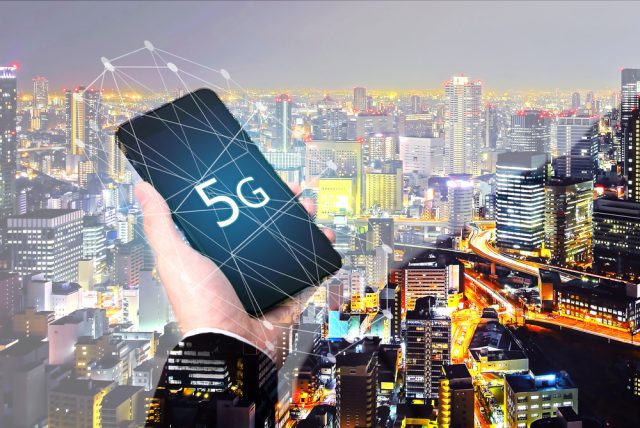5G's 'G-wiz' environment

The U.S. is leading in 5G. That’s the latest findings from the Cellular Telecommunications Industry Association’s (CTIA’s) 2019 Annual Survey. But hold the smartphone! According to CNN’s June 26, 2019 article titled, Huawei is still signing up 5G customers despite US pressure, "Huawei is a leader in 5G technology and has invested $4 billion over the last decade in developing the next generation of wireless technology…"
When it comes to the 5G measuring stick, "leading," "readiness," and "patents" all have dramatically different leaders. For example, according to the CTIA report, being ready for 5G means building the required infrastructure, and testing and launching early networks in key locations. The report cites that AT&T has launched 5G in over a dozen markets, while Chinese 5G networks are still in trial stages -- advantage U.S.
However, according to a Wall Street Journal (WSJ) article published February 26, 2019, titled, Where China Dominates in 5G Technology, "The Chinese tech juggernaut [Huawei] as of early February owned 1,529 'standard-essential' 5G patents, the most of any company. Together with patents owned by ZTE, the state-owned China Academy of Telecommunications Technology, and Guangdong Oppo Mobile Telecommunications Corp., companies from China own 36 percent of all 5G standard-essential patents." By contrast, the same WSJ article found that U.S. firms, including Qualcomm and Intel Corp, hold just 14 percent of critical 5G patents.
Can They Build It? Will You Come?
Although 5G readiness, patents, and partnerships are important, the global user base will have to wait a while before they're able to access the speedy connections because of the need to release more spectrum for 5G traffic. Right now, it seems like the telecommunication industry is laying railroad tracks with very little real estate to place them on and too few locomotives in existence.
5G’s manifest destiny is a certainty and the gold rush to stake a claim on faster wireless speeds is on. Since the launch of 4G in 2010, the industry has made over $253 billion in capital investments. In 2019, the industry’s investments increased $1.8 billion to a total of $27.4 billion, in addition to the 349,344 cell sites operating in 2018 -- up 8 percent.
From a data-flow perspective, the effective distance for a 5G cell on a watt-by-watt comparison to 4G is significantly reduced, requiring more hardware and site locations to have 5G coverage. This reception gets even more complicated in high-use, dense metropolitan areas, as buildings will have to either be fitted with distributed antenna systems and 5G picocells or rely on a handoff of traffic to new Wi-Fi 6 infrastructures.
U.S. telecommunication and chip companies making 5G capital investments also need to work hand-in-hand with the Federal Trade Commission to ensure greater amounts of radio spectrum are available. This is in addition to new techniques such as dynamic spectrum-sharing and directional beamforming currently being considered to maximize throughput and ensure 5G quality-of-service.
Smartphone & Smart-City Data Needs Smart Power
As 4G helped to give birth to Uber and Lyft, so too will 5G’s lightning-fast wireless speeds lead to more innovations. It’s not all about the new smartphones, 5G services will breathe new life into data-only devices such as IoT sensors. Now smartphones will have smart-cities to reside in, where 5G will provide the network transport for cameras, gunshot detectors as well as parking space, air & water quality monitors and numerous other IoT-enabled devices.
Data-only devices such as self-driving cars, smart watches, and health monitors connected by wireless networks, jumped over 10 percent in 2019 to 139.4 million devices.
These new bandwidth-hungry devices generate massive volumes of data in more places, greatly expanding the need for local processing and storage -- exacerbating the deployment of edge computing.
Because 5G networks require more transmitters operating in denser areas, the service will need edge computing to process the workload closer to the point where data is collected to eliminate latency. In order to ensure uninterrupted power flow and efficiency, these micro-data centers a.k.a edge computing, require smarter, data center PDUs for delivering electrical power.
Carriers running hundreds of edge computing sites should opt-in for sourcing renewable energy in the form of solar, wind, or hydroelectric power. Some of it will be delivered through the utility grid and some will be generated locally at the point of consumption. The vast majority of the power will need to be remotely monitored and managed through automation to ensure uptime while maintaining efficiency and avoiding truck rolls.
Solutions for indoor installations will be different from outdoors in both size and functionality. Some sites will utilize DC power, while others will require AC power. Having the ability to see and manage both AC and DC through a common interface is critical to enabling AI software to work its magic and ensure the networks operate reliably. Either way, intelligent power distribution units (PDUs) or switched PDUs that offer environmental monitoring data will be a must-have to lower operational costs and improve efficiency.
Conclusion
Unlike other much-hyped technologies that contributed very little improvements to our every-day lives, 5G networks are poised to have a dramatic and positive impact throughout the world in the very near term. Those who benefit from 5G services do not have to be the bearer of a thousand-dollar smartphone, they will realize its benefits through enhanced health, security, and transportation services -- just to name a few.
Simplified connectivity and standards-based chips will help ease usage and stimulate new innovations that continue to drive services in a 5G economy. Some federal or governmental agencies that hold underutilized spectrum may have to share it to ensure the new data ecosystem has the bandwidth to transport promised services. Finally, enhancements must be replicated through the edge networks in the form of alternative energy sources and innovative, space-saving power distribution units that are as smart as the devices and networks they power.
Photo Credit: Shaynepplstockphoto/Shutterstock
 Marc Cram is Director of New Market Development for Server Technology (@ServerTechInc), a brand of Legrand (@Legrand). Marc is driven by a passion to deliver a positive power experience for the data center owner / operator. Marc brings engineering, production, purchasing, marketing, sales, and quality expertise from the automotive, PC, semiconductor and data center industries together to give STI customers an unequalled level of support and guidance through the journey of PDU product definition, selection, and implementation. Marc earned a BSEE from Rice University, and has over 30 years of experience in the field of electronics.
Marc Cram is Director of New Market Development for Server Technology (@ServerTechInc), a brand of Legrand (@Legrand). Marc is driven by a passion to deliver a positive power experience for the data center owner / operator. Marc brings engineering, production, purchasing, marketing, sales, and quality expertise from the automotive, PC, semiconductor and data center industries together to give STI customers an unequalled level of support and guidance through the journey of PDU product definition, selection, and implementation. Marc earned a BSEE from Rice University, and has over 30 years of experience in the field of electronics.
